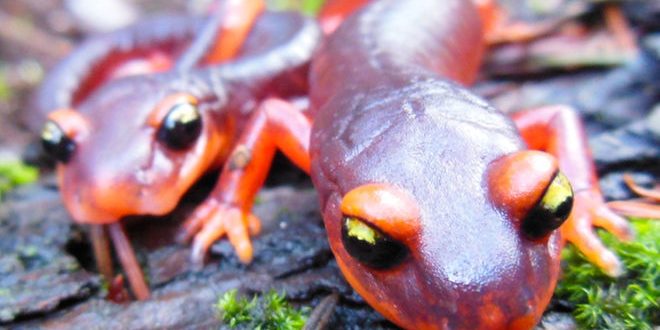North America is home to 190 of the world’s 655 identified salamander species and while they have avoided a deadly fungus that has ravaged the salamander population in Europe.
At issue is salamander chytrid disease, caused by a fungus that infects both salamanders and newts with near total lethality. The fungus, known as B.sal, infects the skin, causing wart-like lesions. As the disease progresses, the animal stops eating, becomes lethargic, loses control of its body movements and eventually dies.
Originally from Asia, the disease has completely wiped out wild populations where it has appeared in Europe and the U.K., said Natacha Hogan, an environmental toxicologist specializing in amphibians at the University of Saskatchewan.
“It’s basically the pet trade,” she said. “It’s when you start moving salamanders; this is what this spread has been attributed to. There c have been millions of salamanders imported—how many kids own fire belly newts from a pet store?”
While the fungus has not yet been spotted in Canada, she said the U.S. has already instituted strict regulations on trade in salamanders and newts.
The Canadian Wildlife Health Cooperative (CWHC) is leading efforts to raise the alarm, urging immediate action. The group compares the threat to a similar invasive fungal disease that all but wiped out entire species of frogs in South and Central America, and white nose disease, which has killed entire colonies of bats—millions of animals—across North America, including Canada.
While Canada has only two species of newt—both in Ontario—salamanders are wide spread, Hogan said, with about 15 species across the country. Some of these have a small geographic range, but others, such as the two species of tiger salamander found in Saskatchewan, can be found right across the Prairie provinces.
The rest of North America is even more richly endowed.
“The U.S. has among the greatest biodiversity of amphibians in the world, so this is also true of salamanders and newts,” Hogan said.
The CWHC emphasizes first line of defense starts at home to help safeguard this rich natural heritage, and offers online resources for both pet owners and scientists.
“If you must keep salamanders or newts as pets, ensure they are from locations where (the fungus) is not present and only buy from reputable suppliers,” the group urged in a release. “Make sure any water or cage wastes are properly disinfected with bleach before discarding them. Always seek appropriate veterinary care for sick pet salamanders and newts.”
Bleach is the disinfectant of choice for biologists in the field and lab, explained Hogan. She did field work on a similar fungal disease in native frogs while at the University of Prince Edward Island. Whenever she and her colleagues left one pond to go to another, all their gear—including gloves, boots and sampling equipment—got doused in a 10 per cent bleach solution. They even sprayed down the tires of their vehicles as they were leaving to avoid bringing any trace of contaminated soil to the next pond.
“The fungus makes these little zoospores that can even swim on their own a short distance,” she explained. “They can live in water, in mud, so movement of those materials as you go from one wetland to another and you haven’t cleaned your boots…”
Hogan emphasized another two points: do not handle wild salamanders, and never, ever release pet animals into the wild. If that pet salamander has lost its allure, the best solution is to return it to the store or bring it to the veterinary college.
With their shy nature, salamanders keep a low profile that belies their importance to the ecosystem, where they occupy a niche similar to that of frogs and toads. They eat insects and other aquatic invertebrates and are in turn eaten by fish, birds and small mammals.
“Amphibians are key components within the food web,” Hogan said. “A decline or elimination of even one species will have some impact, a trickle-down effect on other species within that food web.”
Agencies/Canadajournal
 Canada Journal – News of the World Articles and videos to bring you the biggest Canadian news stories from across the country every day
Canada Journal – News of the World Articles and videos to bring you the biggest Canadian news stories from across the country every day



